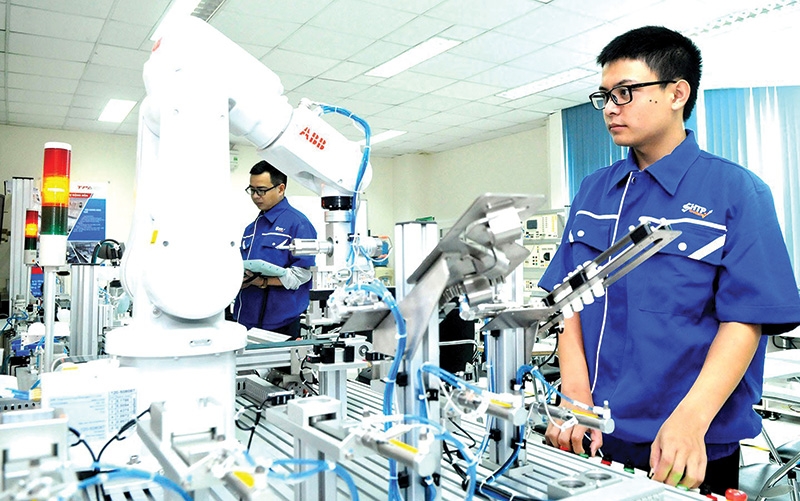Reaching the next level of high-quality growth
 |
| Pham Hoang Mai, director general of the Department of Science, Education, Natural Resources, and Environment at the Ministry of Planning and Investment |
The Fourth Industrial Revolution, characterised by new technologies such as automation and robotics, is taking a foothold across the world and creating a new impetus for socio-economic development, facilitating Vietnam to catch up with more advanced nations.
Studies show that by 2030, Vietnam’s participation in Industry 4.0 can help the country increase GDP by an additional $28-63 billion, depending on the level of technological application in enterprises. This increase is tantamount to a rise of an additional 7-16 per cent of GDP by 2030, as compared to a scenario without the implementation of Industry 4.0.
This new era will create changes in the employment structure of the economy, with the generation of around 2.7-2.9 million more jobs. Labour productivity will also increase by another $315-640 million.
In addition to limitations in infrastructure, and capacity in science and technology, Vietnam also has lots of potential for deploying Industry 4.0 efficiently. Positive factors include a large population of nearly 100 million people, a high rate of mobile phone subscribers (139 subscribers per 100 people) which is far more than the rest of the world, and a young labour force with good training, especially in the IT sector which is considered a firm foundation for Industry 4.0 development.
Industry 4.0 offers great opportunities for Vietnam to quickly improve competitiveness and growth quality, as well as escape from the danger of lagging behind other nations.
Embracing innovation
Taking advantage of this era is the quickest way to ensure Vietnam is more modern and prosperous, and thus it is quite necessary for the country to concentrate resources to implement it.
However, in order for Vietnam to succeed in materialising the Fourth Industrial Revolution, it is necessary to have a positive view in technology and innovation, which must be considered as a good opportunity for solving development-related issues. Therefore, it is necessary to create the best conditions for the encouragement of technological development and innovation.
The implementation of the national strategy on Industry 4.0 will be a key solution to the deployment of the nation’s economic restructuring, and the renewal of the growth model and socioeconomic development strategies.
In addition, special attention must be paid to institutional reform and improvement of the socialist-oriented market economy, as well as manifestation of an e-government. This will be a prerequisite for the implementation of this new era in Vietnam.
Furthermore, it is also necessary to boost international co-operation with other nations, technological hubs, advanced tech firms, and leading scientists and intellectuals, including Vietnamese people based overseas.
This is a very important method for Vietnam to realise Industry 4.0, take advantage of the brainpower of humankind, and develop more quickly and sustainably.
However, implementing this new revolution is a long process which would need focal activities and programmes suitable with the development level of the economy, and the requirements of the country.
Nevertheless, the government needs to take the initiative in drastically changing governance methods and developing a sturdy institutional and technical foundation to implement of Industry 4.0.
It is necessary to mobilise resources in order to soon develop the necessary foundations for realising Industry 4.0. These foundations include three factors. The first is a modern institutional system compatible with renewal and innovation in order to boost investment into technological application and innovation. The second is strong technical infrastructure so as to facilitate this innovation. The final factor is human resources sufficient in quantity and quality in order to deploy it.
 |
| The gains for Vietnam in Industry 4.0 implementation could be vast, with a huge jump in GDP within attainable reach, Photo: Le Toan |
| Ousmane Dione - World Bank country director for Vietnam
In terms of digital adoption, Vietnam’s journey contains strengths and challenges. The World Bank’s Development Report 2016 on Digital Dividends ranked Vietnam’s Digital Adoption Index at 0.46 on a one-point scale. While higher than the average of global lower middle-income countries, it is lower than the regional average. Internet penetration is 54 per cent, and 40 per cent of Vietnam’s population are social media users. And while those numbers are impressive, according to a recent survey of Alphabeta, Vietnam fares lowest in the region in other digital measurements. To forge ahead or even leapfrog others, Vietnam must upgrade the way its government functions. Three types of government relationships are critical: government to government, government to business, and government to citizens. Technologies can help in many ways, if we can embrace them strategically to reverse potential disruptions to these relationships. But technology alone cannot solve the puzzle. Simply buying software or hardware will not improve the way government functions, and the government will not be a partner to Industry 4.0 if it is stuck in bureaucracy 1.0. |
Taking the proper path
In addition, the country is required to select suitable sectors and technologies for boosting the application of scientific and tech achievements in order to catch up with and maintain alignment with the world in using popular technologies.
At the same time, the government also needs to boost investment with proper focus, and suitable priorities and roadmaps, so that the country can become a leader in some prioritised technologies.
It is quite necessary for Vietnam to develop in this way so that the country can reach a higher development level, becoming an economy with high-quality growth, high productivity, and high competitiveness globally.
This will also help transform Vietnam into a medium- to high-income nation with a modern society, in which development issues will be solved, and livelihoods will be improved based on the application of high technology in production, governance, provision of public services, and the betterment of the living environment.
One of the biggest solutions to implement Industry 4.0 is the institutional reform of the domestic business climate, especially in the sectors with great potential for implementation such as manufacturing, processing, agriculture, finance, logistics, healthcare, and education.
Moreover, the government should place more investment into constructing a number of international-standard innovation centres in Vietnam. Specifically, the government should use its budget to encourage the private sector to engage in establishing innovation centres under the best models.
This should be carried out in order to create a cradle for the country’s startup ecosystem, boost research and development activities, create new products and services based on 4.0 technologies, and multiply successful models in all localities throughout the country.
Leading local and foreign technological corporations and investors must also be attracted into implementing hi-tech projects in the country, and co-operating with innovation centres so as to support startups in development and commercialising their novel ideas, patents, inventions, and new business models.
The government could also co-operate with private investment funds in pouring money into startup projects selected by innovation centres and financiers.
In addition, the government also needs to enact special mechanisms and policies in favour of these centres, so that enterprises can conduct studies and develop products.
Finally, it is also necessary for the government to attract capital and technology from external resources in order to implement the Fourth Industrial Revolution to its fullest potential.
What the stars mean:
★ Poor ★ ★ Promising ★★★ Good ★★★★ Very good ★★★★★ Exceptional
Themes: SMART SUSTAINABILITY
Related Contents
Latest News
More News
- Main drivers for Vietnam’s digital economy future (December 03, 2025 | 11:35)
- Pivotal stage of growth paves way for rise in M&As (December 03, 2025 | 10:00)
- Positive projections for M&A interest from Thailand (December 03, 2025 | 09:40)
- Manifesting the first line of defence in cybersecurity (December 03, 2025 | 09:00)
- The transformational role AI can play in accounting arena (December 03, 2025 | 08:00)
- Unlocking 5G-AI potential in Singapore (December 03, 2025 | 08:00)
- Data-driven strategies vital for a fast-evolving nation (December 02, 2025 | 09:41)
- Policy to practice: how Vietnam can lead the region (November 26, 2025 | 16:03)
- Mobilising private capital at scale vital for climate battle (November 26, 2025 | 15:36)
- VILAF and Yoon & Yang launch Vietnam - Korea Practice Unit (November 26, 2025 | 15:16)


 Tag:
Tag:





















 Mobile Version
Mobile Version